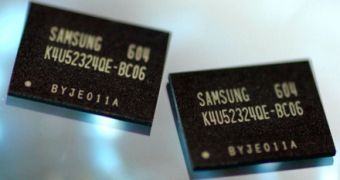There are still many discrete graphics cards that use the older GDDR2 standard, even if high-end cards use GDDR3 or are in the process of adapting to the newer and faster GDDR4. This is the climate where Samsung decided to throw a new graphical memory standard in the mix: GDDR5. Because the widespread use of video cards sporting the GDDR4 memories is still some time away, it is really surprising that a company is inclined to make such a move.
As the most powerful and important video DRAM producer and evaluated member of JEDEC, the institution that ratifies the memory standards, Samsung's support for any memory standard is important. When GDDR5 showed up on a roadmap concerning DRAM evolution recently published by Jon Peddie Research, it signaled the start of standardization efforts. According to this source, GDDR3 will get a new revision, that will help both speed and lower-en video cards that still use DDR2 to make the transition. This new revision of GDDR3 will have a higher speed per pin (2400Mib/sec/pin), as it appears on the roadmap and it will be introduced soon.
The GDDR4 standard could disappear however, as only a few cards and producers are currently implementing it. More so since Samsung has no plans to refresh its GDDR4 products, or upgrade them to sustain higher speeds, memory densities or voltages. The GDDR4 line tops at about 3200/Mib/sec/pin and 1.9V, although there are no video cards around (and not in the near future either) that could use all that speed.
The highlight of Samsung's roadmap, the GDDR5 standard, should enter mass production in the first month of 2008 and 1GB densities should be available starting with the second trimester using the D-die production process. GDDR5 will increase speed from 3200 (GDDR4 standard speed) to 5000Mb/sec/pin, using Samsung's G-die production process. The G-die appears to be using a large 50nm DRAM die and a high Vdd to minimize static current buildup and leakage.

 14 DAY TRIAL //
14 DAY TRIAL //